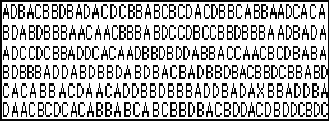|
Joe Davis
My introduction to molecular biology stemmed directly from a project
pertaining to extraterrestrial communications I had mounted with
colleagues from Harvard and MIT in the early 1980's. That project,
called Poetica Vaginal was a project to transmit human vaginal contractions
into deep space for the purpose of communicating with aliens. Problems
associated with interstellar radar transmission and the search for
extraterrestrial intelligence automatically led me to consider the
"universal" language of biology; convenient and economical production
of astronomical numbers of individual entities (messages); robust
media (bacterial spores and viruses) that could survive both environmental
rigors of the space environment and periods of "geologic time" that
would be required for the "journey out".
At Ars Electronica I plan to install a novel instrument I have recently
developed and several examples of my work constructed from synthetic
molecules of DNA. The first of these artistic molecules, Microvenus,
contains a coded visual icon representing the external female genitalia
and by coincidence, an ancient Germanic rune representing the female
Earth. Later, I learned to sequence or "read back" DNA molecules
(including this one) with Shuguang Zhang and Curtis Lockshin at
Alexander Rich's laboratory at MIT. Techniques used to encode visual
messages for extraterrestrial intelligence were co-opted to encode
the Microvenus graphic information and a short decoding primer into
a 28-mer DNA molecule.
Another molecular artwork to be exhibited, Riddle of Life, is the
culmination of an interesting but little known episode in the history
of science. In the fall of 1958, biophysicist Max Delbrück sent
a mysterious telegram to George W. Beadle at the Nobel prize ceremonies
in Stockholm, Sweden. Delbrück had composed his telegram in a form
that reflected some new and exciting ideas about the nature of DNA
and the operation of the genetic code. It was also an important
precedent for the idea that extrabiological information - in this
case, English language - could be contained in genetic form. The
telegram was sent as one continuous 'word' with 229 letters:

The key to unraveling the message was that it mimicked the triplet operation of DNA. In Stockholm, Beadle managed to crack Delbrück's code and read the English sentence:
"BREAK-THIS-CODE-OR-GIVE-BACK-NOBEL-PRIZE-LEDERBERG-GO-HOME-MAX-MARKO-STERLING."
Beadle replied with a slightly different triplet code of his own. When Beadle's telegram arrived at Delbrück's laboratory at Caltech, the return message was deciphered:
"GWBTOMDIMSUREITSAFINEMESSAGEIFICOULDDOTHEFINALSTEP"
Evidently, Delbrück and the group at Caltech weren't ready to let the recent Nobel laureate have the last word. So, they rallied with yet another mysterious message.
At a formal lecture after the Nobel prize ceremonies in Stockholm, Beadle was presented with a molecular model constructed from toothpicks (Delbrück had airmailed it to the presiding officer). Each toothpick was stained with one of four colors. Like the coded telegrams, the toothpick model also contained an English language message, but with a code made up of colors rather than letters. This time, Delbrück chose to encode a poetic message that embodied a theme important to the history of both the sciences and the arts. The model contained the message "I am the riddle of life. Know me and you will know yourself."
Delbrück and Beadle had ingenious ideas for expressing human language in the form of DNA, but in 1958 no synthetic, or artificially constructed nucleic acids were available. I organized a project to create DNA corresponding to Max Delbrück's toothpick molecule with the Laboratory of Molecular Structure at MIT Biology (Alexander Rich Laboratory), and the Burghardt Wittig Laboratory at the Institute for Molecular Biology and Biochemistry at the Free University of Berlin, Germany. Max Delbrück's RIDDLE OF LIFE molecule that was first conceived of over 40 years ago actually first came into existence in Berlin in December/January, 1993-94.
Note: The preparations for our installations at Ars Electronica
are now partly supported by the MIT Council for The Arts.
|
